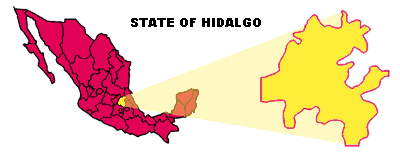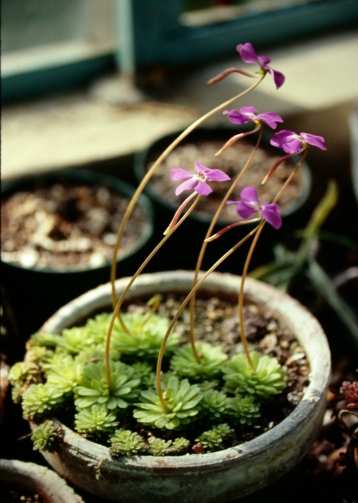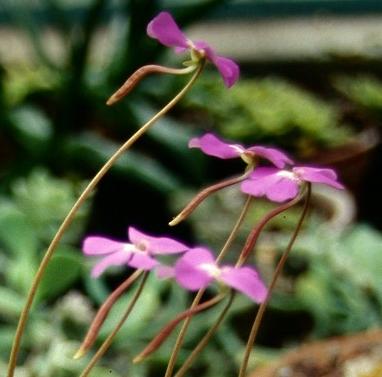Pinguicula ehlersiae Speta & Fuchs (1982)
(cliquer sur le drapeau pour la
version : )
go to : Home
index of species
TAXONOMY:
Family :
Lentibulariaceae
Genus :
Pinguicula
Name :
Pinguicula ehlersiae
Sub-classification
(Casper)
: link
Publication :
By Speta
F. & F. Fuchs (1982): Neue Pinguicula-Arten
(Lentibulariaceae) aus Mexiko. —
Stapfia 10 : 111-119.
Synonyms
: According to the carnivorous plants database of Jan Schlauer in the ICPS
:
- -
Pinguicula cyclosecta {auct. non Casper: Hort.}
P:
in sched. (1984)
-
S:
= Pinguicula ehlersiae {Speta & Fuchs}
- - Pinguicula
ehlersiae {Speta & Fuchs} var.albiflora {Debbert ex
Duschek}] nom.nud.
-
P:
Taublatt 1993, 2:27 (1993)
-
S:
= Pinguicula ehlersiae {Speta & Fuchs}
- - Pinguicula
hintoniorum {B.L.Turner}
-
P:
Phytologia 74:71 (1994)
-
T:
below Puerto Pino, Dr. Arroyo, Mpio. Zaragoza, Nuevo Leon, MX, 16. 3.
1993, G.B.Hinton & al. 22661 (TEX)
-
S:
= Pinguicula ehlersiae {Speta & Fuchs}
DESCRIPTION :
-
soon -
translation
:
-
soon -
ORIGIN AND HISTORY :
The
type specimen of this species was collected near Guadalcazar in the Mexican
state of San Luis Potosi by Mrs Renate Ehlers in 1979.
The
plant was introduced and grown in the botanical garden of Linz where F. Speta
and F. Fuchs published it under the name Pinguicula
ehlersiae.
It
is easy to understand the etymology of the name.
Map / LOCALISATION :
Here
are some named locations of P. ehlersiae.
San
Luis Potosi :
-
Guadalcazar
-
Santa Gertrudis
-
Santa Catarina
-
Nunez
-
El Huizache
-
Ascension (San Luis Potosi ?)

(click
on the map for better location and relief map)
Hidalgo
:
-
North of Ixmiquilpan, San Andres de Debortha
-
Tolantongo

(click
on the map for better location and relief map)
HABITAT:
No
data on the type specimen habitat was published but P. ehlersiae can be found at altitude betwenn 1200 to 1650 m on
gypsum substratum. More soon on a postcard of Fernando Rivadavia.
TEMPERATURE
and PRECIPITATIONS :

Click
on the graph to enlarge and see the graph of normal precipitation and normal average temperatures.
Normal values are 30-year averages for the period 1961 to 1990. The weather
stations are grouped by region (see map of weather
stations).
Introduction in culture
:
This
species can be easily found worldwide in many carnivorous plants collections
and carnivorous plants nurseries.
CULTURE
AND MULTIPLICATION :
(North
hemisphere, France
near Paris, in a polycarbonate greenhouse - see the map
-)
Life
cycle :
The
life cycle observed in culture for this Pinguicula
consists of two seasons, one wet and the other dry (see link).
The plant forms different leaf rosettes according to the season. During the
resting months (winter) the small succulent rosette is composed of numerous
non-carnivorous leaves. The carnivorous leaves are produced in spring and
during all summer. The life
cycle of the plant is probably similar in it's native habitat but I have no
data.
Media
: I use a 100 % mineral media : 2 perlite, 2 vermiculite,
1 small sand (for aquarium), 1 fine white sand, 1 pouzzolane (volcanic lava),
1 aqualit (expansed ceramic for aquarium). The aqualit can be replaced by 1 of
pouzzolane. Plants in this media grow slower but have a stronger root system.
Pot
:
plastic,
colour terracotta, diameter 12.5cm, height 12cm.
Cultivation
:
I
think that a slightly airy situation inside the greenhouse is important
to avoid air stagnation. For this reason, I use a fan 24h/24h all the year
round.
Watering
is very important : from
May to September (summer). I let the media drying slightly between two
watering. I use rain water poured on the top of the pot taking care not to wet
the rosette. From October to April, It is important to let the media
drying completely (no watering) but with an atmospheric humidity of about 80%.
The
mentioned months are indicative and can change according to your own growing
conditions. In fact, when this Pinguicula
begins to produce its non-carnivorous leaves, you have to stop watering and
let the pot drying out completely. Inversely, when the plant begins to produce
in early spring its carnivorous leaves, you have to progressively start
watering again the pot.
Temperatures
: during growth period, day temperatures are about 25°C but may reach 35°C
when the sun is shining on the greenhouse in spite of the use of shading
covers. Night temperatures are around 20°C. During resting period : day/night
over freezing point. Lower temperature observed : - 4°C. I use an
electronic petroleum heater to provide heat.
Multiplication
:
I
have succeeded once in pollinating the flowers of this Pinguicula but
the seeds didn't germinate. The plants can be propagated very
easily using non-carnivorous leaves separated from the rosette at
the end of winter. You only have to carefully tear out the totality of the
leaf including the white base as the plantlets will sprout from this area.
Summer leaves can be used too.
PICTURES: (click to
enlarge)
|
.jpg)
Pinguicula ehlersiae
var albiflora
Photo
: J. Flisek |
.jpg)
Pinguicula
ehlersiae var albiflora
just before opening of the flower.
Photo
: J. Flisek |
|
.jpg)
P.ehlersiae
'Tolantonga'.
Photo : J. Flisek |
.jpg)
P.ehlersiae
'Ixmianilpan, Hidalgo'.
Photo : J. Flisek |
|
.jpg)
Comparison
of various forms of P.ehlersiae : "Ixmianilpan,
Hidalgo" (left), var. albiflora, "Tolantonga" (bottom)
and "Santa Catarina" (right).
Photo : J. Flisek |
.jpg)
P.ehlersiae
'Santa Catarina'.
Photo : J. Flisek |
|
.jpg)
Pinguicula ehlersiae
'type'
Photo
: O. Gluch
www.gluch.info |
.jpg)
Pinguicula ehlersiae
'type'
Photo
: O. Gluch
www.gluch.info |
|
.jpg)
P. ehlersiae in
habitat near El Huizache
Photo : F.Rivadavia |
.jpg)
Flowers
of Pinguicula ehlersiae from El Huizache in Adolfo's greenhouse.
Photo : F. Rivadavia |
|
.jpg)
Another
flower of Pinguicula ehlersiae from Nunez in Adolfo's greenhouse.
Photo : F. Rivadavia |
.jpg)
Another
flower of Pinguicula ehlersiae from Nunez in Adolfo's greenhouse.
Note the variation between these two flowers.
Photo : F. Rivadavia |
|

Pinguicula
ehlersiae 'Ascension', in Alfred Lau's greenhouse. Note the amazing
hooked spur.
Photo : Ed. Read |

Pinguicula
ehlersiae 'Ascension', in Alfred Lau's greenhouse. Note the amazing
hooked spur.
Photo : Ed. Read |
| |
|



.jpg)
.jpg)
.jpg)
.jpg)
.jpg)
.jpg)
.jpg)
.jpg)
.jpg)
.jpg)
.jpg)
.jpg)

